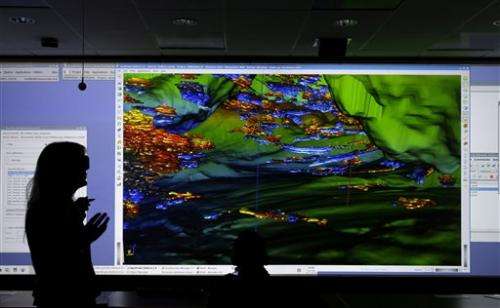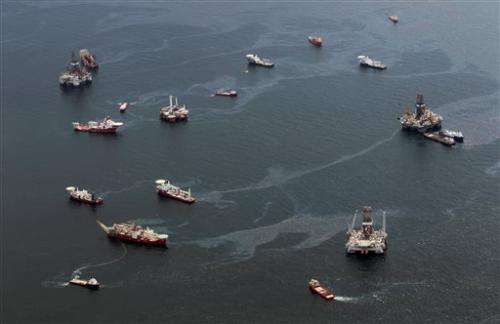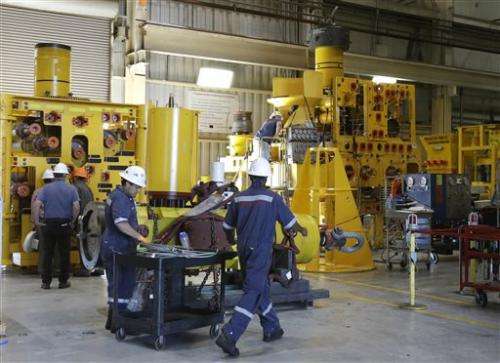BP pushes technical limits to tap extreme fields

BP's strategy after the Deepwater Horizon tragedy: Go deeper.
BP is leading an industry-wide push to develop technology that can retrieve oil from formations that are so deep under the sea floor, and under such high pressure and temperature, that conventional equipment would melt or be crushed by the conditions.
One BP field in the Gulf of Mexico, called Tiber, makes the Macondo field that the Deepwater Horizon rig was probing look like simple puddle of oil. It is thought to hold 20 times the amount of oil as Macondo. At 35,000 feet (10,600 meters) below the sea floor—6.6 miles (10.6 kilometers) into the earth's crust—it is about twice as deep.
There's an extraordinary amount of oil in similar discoveries around the world, several of which are controlled by BP. But BP first must figure out how to get it. New equipment, including blowout preventers far stronger than the one that failed on the Deepwater Horizon, must be developed. Then BP must convince regulators it can tap this oil safely.
Another disaster could threaten BP's existence, but success could restore the company's fortunes—and perhaps its reputation. "There's 10 to 20 billion barrels of oil just for BP in this," says Kevin Kennelly, who runs BP's global technology operations. At today's prices, that's worth up to $2 trillion.
After the Deepwater Horizon exploded, killing 11 workers, and spewing between 103 million and 176 million gallons of oil into the Gulf, questions were raised by regulators, engineers, environmentalists and others over whether BP—or any oil company—could safely produce oil from formations under thousands of feet of water and tens of thousands of feet of rock.
Three years later, there are a record 39 rigs drilling in the deep waters of the Gulf of Mexico, according to IHS Petrodata, as drillers probe enormous troves of oil in untapped formations—some of which are under especially high temperature and pressure.
And it is BP, of all companies, that is pioneering the push to exploit the most difficult of them.
Environmentalists are alarmed. "You hope (BP) has learned their lesson, but the nature of the business is that there are going to be spills, there is human error," says Athan Manuel, director of the Sierra Club's lands protection program. "These high pressure wells could cause another environmental disaster in the Gulf."
For BP, drilling deeper is a bold and crucial step. CEO Bob Dudley told colleagues at an industry conference last year that management "thought very carefully before re-committing the company to the deep water following the 2010 accident." The spill has cost BP $42.5 billion, and legal battles are ongoing.

BP decided to go forward in a major way. Dudley may not have had much choice—BP needs the oil. Its production is down 21 percent since the oil spill and its share price is 22 percent lower. Big oil companies need to find giant fields to generate enough oil to replace the steady natural declines of existing fields. These big fields are now only found in remote or difficult locations.
Despite the Deepwater Horizon accident and BP's errors that contributed to it, BP remains one of the few companies with the technical expertise and financial resources to discover and produce oil at these depths. It is the biggest producer, investor and leaseholder in the Gulf of Mexico, which even with the onshore oil boom in states such as Texas and North Dakota still accounts for 17 percent of domestic production. BP recently added two more rigs in the Gulf, bringing its total to nine, more than it has ever had there.
The company's new prospects are among the largest in the Gulf in a part of an emerging geologic formation called the Lower Tertiary. These layers of rock are far older, and deeper under the sea floor, than the Miocene formation responsible for most of the Gulf of Mexico's current oil production.
The Lower Tertiary, once thought to have no oil and gas, is also being explored by Exxon, Chevron, Shell and others. Some of the shallower locations are already producing oil, and over the next 15 years it is expected to become the dominant source of the Gulf's oil, according to the consulting firm Wood Mackenzie. In all, the formation is thought to hold 15 billion barrels, worth $1.5 trillion.
Current industry equipment, rated to 15,000 pounds per square inch (1,020 atmospheres) and 250 degrees Fahrenheit (121 degrees Celsius), can't produce the oil in BP's Lower Tertiary fields, including Tiber and Kaskida. The rubber now used to seal valves and pipes would melt at more extreme temperatures. Some equipment, such as the blowout preventer, which failed in the Deepwater Horizon accident, is too small to withstand higher pressures. So BP launched a program it calls "Project 20K" to develop equipment with suppliers that can withstand up to 20,000 pounds per square inch and 350 degrees Fahrenheit (176 degrees Celsius).
That's hot enough to bake a chicken, and the equivalent of having the weight of a school bus bearing down on every square inch of equipment.
Some experts wonder if BP, or the rest of the industry, is up to the task.
Robert Bea, professor emeritus of engineering at the University of California and an expert on offshore technology who studied the Macondo blowout, says more than just better equipment must be developed. The especially hard part, he says, is developing a management system that can properly direct and oversee such complex projects. Bea, who has testified for plaintiffs suing BP over the spill, says it takes "decades of concerted work" to do so safely.
"BP's basic thinking has not fundamentally changed," he says. "They want to develop those resources so badly, and they want to develop them so quickly, their drive for production overcomes what should be a comparable drive for protection."

BP says it has overhauled its oversight procedures and can now better identify problems before they crop up. On the 12th floor of a building on the company's Houston campus sits a monitoring center where BP's Gulf of Mexico drilling operations are tracked by engineers. Banks of large screens flicker with live video of each operating rig and columns of data fed by sensors that track the status and performance of the equipment at the drill sites.
The newer equipment developed by BP and its suppliers for Project 20K, including the blowout preventer, will be able to be tested remotely to ensure not only that it is working properly, but that the sensors that detect whether it is working properly are themselves functioning correctly.
Chris Harder, BP's wells operations director, compares the new testing system to a far more sophisticated "check engine" light in a car. "We didn't really know if the car needed a tuneup," he says of the old system.
And BP is working to lower the chances of human error, sometimes with low-tech changes. For example, green "start" buttons and red "stop" buttons will no longer both be round. Instead, one will be a triangle, to help workers more quickly and accurately identify the buttons.
BP says it is also developing new testing procedures that it hopes will help make regulators more comfortable with the new projects. BP will now test whole systems instead of just individual parts in an effort to better simulate real-world conditions. Taking a cue from the aircraft industry, BP will push equipment past its rated limits to see how it reacts when it fails.
A drill ship called West Sirius is drilling into the Tiber field now, and it is well on its way to a final depth of 32,000 feet below the sea floor. It's an appraisal well, meant to determine exactly where BP should eventually place wells that will produce oil and gas when the high-pressure and high-temperature equipment is ready.
But that is still years—and many permits—away. Michael Bromwich, the former head of the Bureau of Ocean Energy Management, Regulation and Enforcement, says regulators understand that is important for the U.S. to continue to develop offshore oil resources and remain a technological leader. But he says they will almost certainly hold BP to a higher standard than other oil companies.
"Whoever reviews it is going to feel pressure, and give it extra scrutiny, it's human nature," he says. "People remember what happened."
© 2013 The Associated Press. All rights reserved.




















